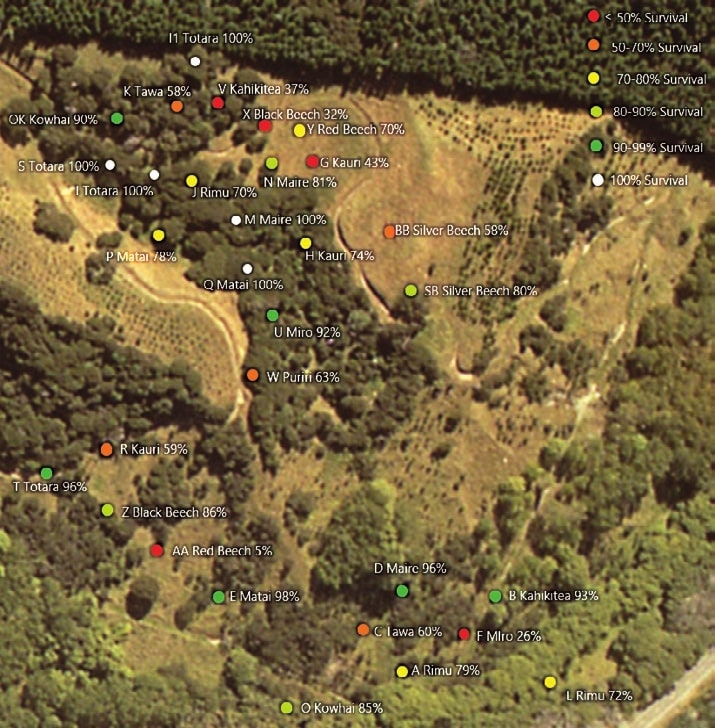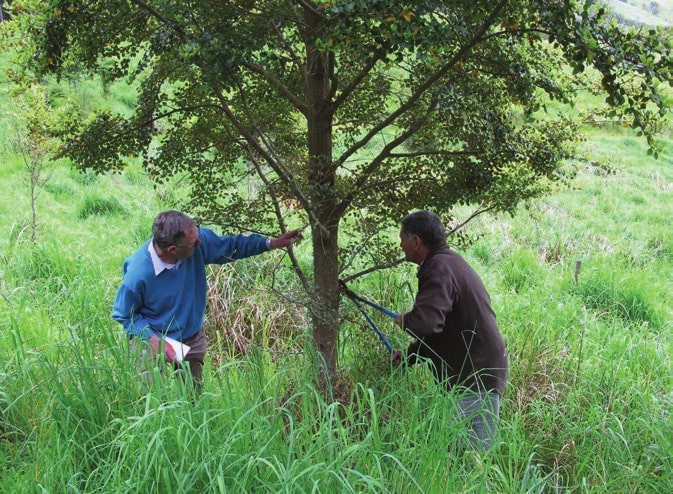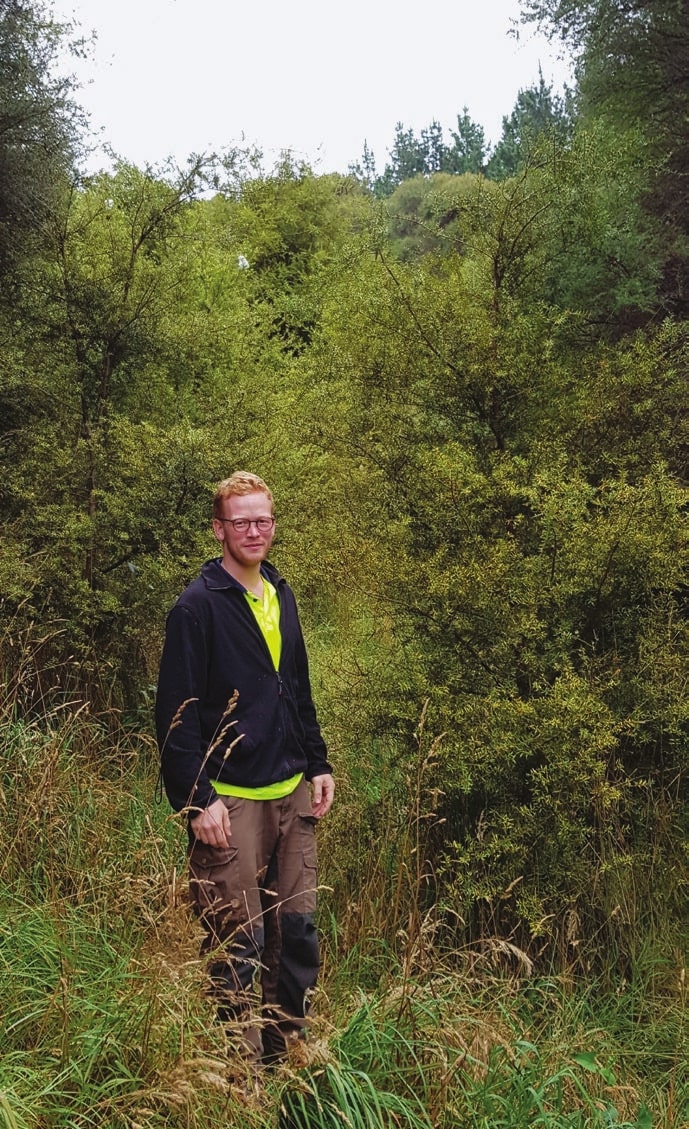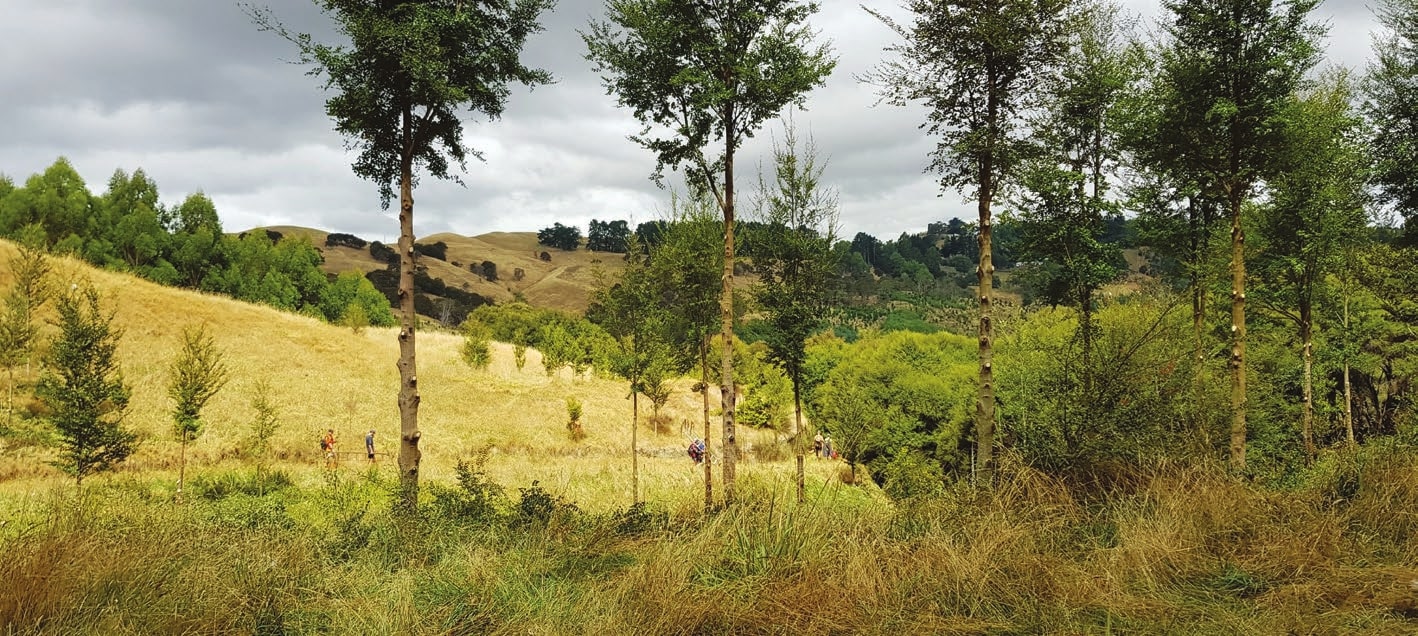Performance of indigenous and exotic species at Rewanui Forest Park ten years on
Dean Meason, Allison Drennen and Harriet Palmer, New Zealand Tree Grower February 2020.
The Montfort Trimble Foundation established 15 indigenous and 11 exotic tree species in Rewanui Forest Park between in 2006 and 2008. The success and failure of species, and the measurements taken, provides information on the suitability of establishing different species in the Wairarapa and provides an important direct comparison between a large number of different exotic and indigenous species on one site.
More than one plot was established for most indigenous species, which makes it possible to assess the site sensitivity of each species and provide an indication of conditions they require to do well. These plots could also provide valuable microsite data for future research on the conditions required for each species.
What was planted
Rewanui Forest Park is a 334-hectare property in eastern Wairarapa owned by the Montfort Trimble Foundation. This is a Masterton-based charity with the aim of bringing trees and people together in the Masterton district and beyond.
In the years 2006 to 2008 a total of 50 trial and demonstration plots were established at Rewanui, 33 of which were planted with one of 15 indigenous species, and 17 with one of 11 exotic species. NZFFA members visited some of the native trials during the action groups weekend in the Wairarapa in November 2017.
In planting the trials, the aim was mainly to learn about, and demonstrate, what was possible on typical eastern Wairarapa hill country. Information about site choice and best-practice establishment techniques for alternatives to radiata pine, especially indigenous species, was in short supply at the time, and demonstration plantings were also scarce. In the current climate of increased new planting, especially of native species in the Billion Trees programme, lessons which can be taken from the trials are probably even more valuable than originally envisaged.
The indigenous trial plots were planted in several locations, including some within regenerating scrub, providing planting positions in full light, partial shade and full shade. There were at least two plots of most of the indigenous species in different, generally contrasting, locations.
The non-native species plots were all in one location – an open, ex-grassland slope with a northerly aspect. Only one plot per species of most of the exotic species was planted as the main aim of these was to demonstrate alternatives to radiata pine. At the time of planting, every tree was located by GPS and marked with a glass fibre rod and numbered tag. Almost all the plots are beside one of Rewanui’s walking or four-wheel drive tracks, enabling easy access for maintenance, monitoring and for interested visitors.

Managing and measuring
In the first two to three years after planting, the ground round the trees was sprayed to reduce competition from surrounding vegetation. Some blanking, which is replacing the trees which had died, was also carried out in the first couple of years, but once established the trees have more-or-less been left to grow. In some cases, trees have had to be release sprayed to tackle Muehlenbeckia, an aggressive creeping indigenous weed which causes major headaches at Rewanui. Surrounding scrub vegetation has grown over some plots, increasing the amount of shade on some trees. The fastest growing exotic species have been pruned and will be thinned to reflect accepted silvicultural practice.
All trees were measured annually for at least 10 years after planting, and records entered into a database. The late chairman, Ian Campbell, developed a software package to interpret and illustrate the survival and growth of the trees, and for many years Ian’s annual summary of how the trees were performing was displayed on a board beside each plot.
Scion and Tane’s Tree Trust have maintained an interest in the trials over the years, and in 2018 there was an offer from Dean Meason at Scion to undertake an analysis of the many years of data available. A summer intern from the United States, Allison Drennen, carried out much of the analysis.

Results of the analyses
Indigenous species
The table below shows the range of the 15 indigenous species planted in trial plots.
Red beech Nothofagus fusca, now renamed Fucospora fusca, reached the greatest height of all the indigenous species after 10 years at 5.3 metres, but had the lowest survival rate at an average of 41 per cent. Deer damage was one cause of mortality. However, survival in the better of the two plots was 61 per cent, showing the potential for this species. Highlights among the other information −
- Tawa Beilschmeiedia tawa performed particularly poorly, with very little growth at all and only a 46 per cent survival rate.
- Black beech Nothofagus/Fucospora solandri and kauri Agathis australis both grew to exceed an average of three metres in height but only had around 50 per cent survival rates. Deer damage to beech was an obvious cause of mortality and kauri did particularly badly in an unshaded plot.
- Rewarewa Knightia excelsa, miro Prumnopitys ferrugine, and kowhai Sophora spps all averaged a height of 2.2 metres. Rewarewa and miro each had a 58 per cent survival rate, and kowhai managed 68 per cent.
- Rata Metrosideros umbellate grew slowly, only reaching an average height of 1.2 metres, but had a survival rate of 70 per cent. As there was only one plot, it is unknown if this is typical for rata here.
- Rimu Dacrydium cupressinum, maire Nestegis cunninghamii, puriri Vitex lucens, and matai Prumnopitys taxifolia all had from 85 to 89 per cent survival, and all grew to an average height of between two and 2.5 metres.
- Totara Podocarpus totara had the highest survival rate of the indigenous species, at 97 per cent and reached an average height of three metres.
As noted in the last bullet point, totara grew the most consistently with an average height of three metres over the four plots with a remarkably consistent survival rate of 97 per cent. Red beech’s growth was much greater than the totara with an average growth of 5.3 metres, but the average survival rate was only 41 per cent. It needs to be pointed out that red beech was only present in two plots, one with a survival rate of 66 per cent, and the other with survival of 15 per cent, so the ‘average’ survival is between these two figures.
If ideal conditions were determined, red beech could be a very worthwhile species to grow. Unfortunately, all indigenous beech species proved to be very attractive to the transient red deer population. This may have been partly because many of the beech plots were located in a sheltered grassy area.
The plots of maire grew to an average height of 2.6 metres and a survival rate of 85 per cent, and silver beech had an average height of 2.9 metres, but a survival rate of 66 per cent.
Analysis of species survival and growth data appeared to indicate that the most successful indigenous plots were located in the concave parts of the slope. Such locations are more likely to have higher soil moisture during the dryer months. Other findings included −
- The plots containing black beech, kahikatea, miro and red beech all recorded greater than 50 per cent variation in survival rates depending on the plot location.
- Kahikatea and black beech did significantly better on southern plots on the downhill position of the hillslope.
- Miro and red beech performed significantly better in their uphill plots.
- Unlike survival, growth rates were not significantly affected by location, with the exception of one plot of totara where the trees were 1.5 metres taller on average than trees in the three other plots. This plot was in a very sheltered, moist and sunny location.


| Species | Botanic name | Number of plots | Plot identification |
|---|---|---|---|
| Black beech | Fucospora (Nothofagus) solandri | 2 | X, Z |
| Kahikatea | Dacrocarpus dacrydiodes | 2 | V, B |
| Kauri | Agathis australis | 3 | G, R, H |
| Kowhai | Sophora | 2 | OK, O |
| Maire | Nestegis cunninghamii | 3 | M, N, D |
| Matai | Prumnopitys taxifolia | 3 | P, E, Q |
| Miro | Prumnopitys ferruginea | 2 | F, U |
| Puriri | Vitex lucens | 1 | W |
| Rata | Metrosideros umbellata | 1 | Rt |
| Red beech | Fuscospora (Nothofagus) fusca | 2 | AA, Y |
| Rewa rewa | Knightia excelsa | 1 | Rr |
| Rimu | Dacrydium cupressinum | 3 | J, L, A |
| Silver beech | Lophozonia (Nothofagus) menziesii | 2 | Bb, Sb |
| Tawa | Beilschmiedia tawa | 2 | K, C |
| Totara | Podocarpus totara | 4 | I1, I, T, S |
Exotic species
The eleven different non-native species planted at Rewanui are shown in the table below. This is a summary of the main points discovered in the research.
- Giant sequoia Sequoiadendron giganteum tied for the highest survival rate of the exotic species at 100 per cent although it had the lowest overall height at 3.2 metres.
- Coastal redwood Sequoia sempervirens Clone 1 also had 100 per cent survival rate and grew to a height of six metres. Clones 2, 3, and 5, and the redwood seedlings, all had very high survival ranging from 90 to 99 per cent. Height ranged from five to 6.5 metres.
- Ovens cypress Cupressocyparis ovensii was the third tallest growing exotic species, with an average height of nine metres and a 97 per cent survival rate.
- ‘Lusitanica’ Mexican cypress Cupressus lusitanica achieved an average height of 8.8 metres and a survival rate of 85 per cent.
- Douglas-fir Pseudotsuga menziesii grew to just below six metres, with a survival rate of 84 per cent.
- Radiata pine was by far the tallest-growing species at 12.8 metres, with a survival rate of 80 per cent.
- Western red cedar Thuja plicata and Japanese cedar Cryptomeria japonica grew between 3.5 metres and 4.5 metres, with a 75 per cent survival rate.
- The 68 per cent of Eucalyptus obliqua which survived reached a height of 10.8 metres. This plot may have been thinned and the activity was not recorded in the database meaning the survival figure is inaccurate.
- Japanese larch Larix kaempferi and the Rotoehu Cupressus lusitanica achieved 4.2 metres and 7.4 metres height respectively, but neither had greater than 54 per cent survival.
- Western red cedar and Japanese larch were both notably poor growers.
| Species | Botanic name | Number of plots |
|---|---|---|
| Brown-top stringybark | Eucalyptus obliqua | 1 |
| Coastal/Californian Redwood | Sequoia sempervirens | Seedlings - 1 Clones - 4 |
| Douglas-fir | Pseudotsuga menzeisii | 1 |
| Giant sequoia/inland redwood | Sequioadendrum giganteum | 1 |
| Japanese cedar | Cryptomeria japonica | 1 |
| Japanese larch | Larix kaempferi | 1 |
| Mexican cypress lusitanica | Cupressus lusitanica | 1 |
| Mexican cypress Rotoehu | Cupressus lusitanica Rotoehu | 1 |
| Ovens cypress | Cupressocyparis ovensii | 2 |
| Radiata pine | Pinus radiata | 2 |
| Western red cedar | Thuja plicata | 1 |
Summary and the future
A number of indigenous and exotic tree species have been successfully established at Rewanui Forest Park. The most successful three indigenous species in terms of survival and growth were totara, maire, and matai.
It appeared that the most successful indigenous plots were located in the concave parts of the slope where it is likely there was more soil moisture during the dryer months. Direct soil moisture measurements are required to see if this is true.
The most successful non-native species was radiata pine. The next three most successful non-native species in terms of survival and growth were coastal redwood, Ovens cypress and Mexican cypress.
The future of the trial plots
The 2019 Scion report concluded with some recommendations for future management of the indigenous and exotic species plots. From a research perspective, these included −
- Recording as much environmental data for each plot as practical such as slope, aspect, soil type, soil wetness, any other relevant factors, and using this data to create a list of environmental factors where each species is successful in terms of survival and growth
- Working with a science provider to collect more complex plot environmental data such as soil fertility, soil physical properties, soil microbes and soil water from each plot
- Planting further red beech plots to explore the potential for this species in other locations.
Improving knowledge of each plot’s environment, and relating this to species’ survival and growth, would certainly be helpful in matching species to site in any future plantings at Rewanui, especially indigenous species. The plantation resource already includes larger-scale areas of redwood and Ovens cypress, both of which are growing well.
The Montfort Trimble Foundation is grateful to Scion for the work which went into analysing the trial data. The annual measurement of the plots has now stopped, but the trees will remain and be maintained for the foreseeable future. We hope there may be some future research use for the trials, and will always be open to other science providers who have ideas on using the trials for research.
Rewanui is open to the public every day of the year, and anyone who wishes to visit any of the trials is very welcome to do so. More information is available at www.trimblefoundation.org.nz, or on the Rewanui Forest Park Facebook page.
Dr Dean Meason is Research Leader, Systems Biology and Risk, Scion. Allison Drennen was a summer intern at Scion in both in 2018 and 2019. Harriet Palmer is on the Board of the Montfort Trimble Foundation.

 Farm Forestry New Zealand
Farm Forestry New Zealand